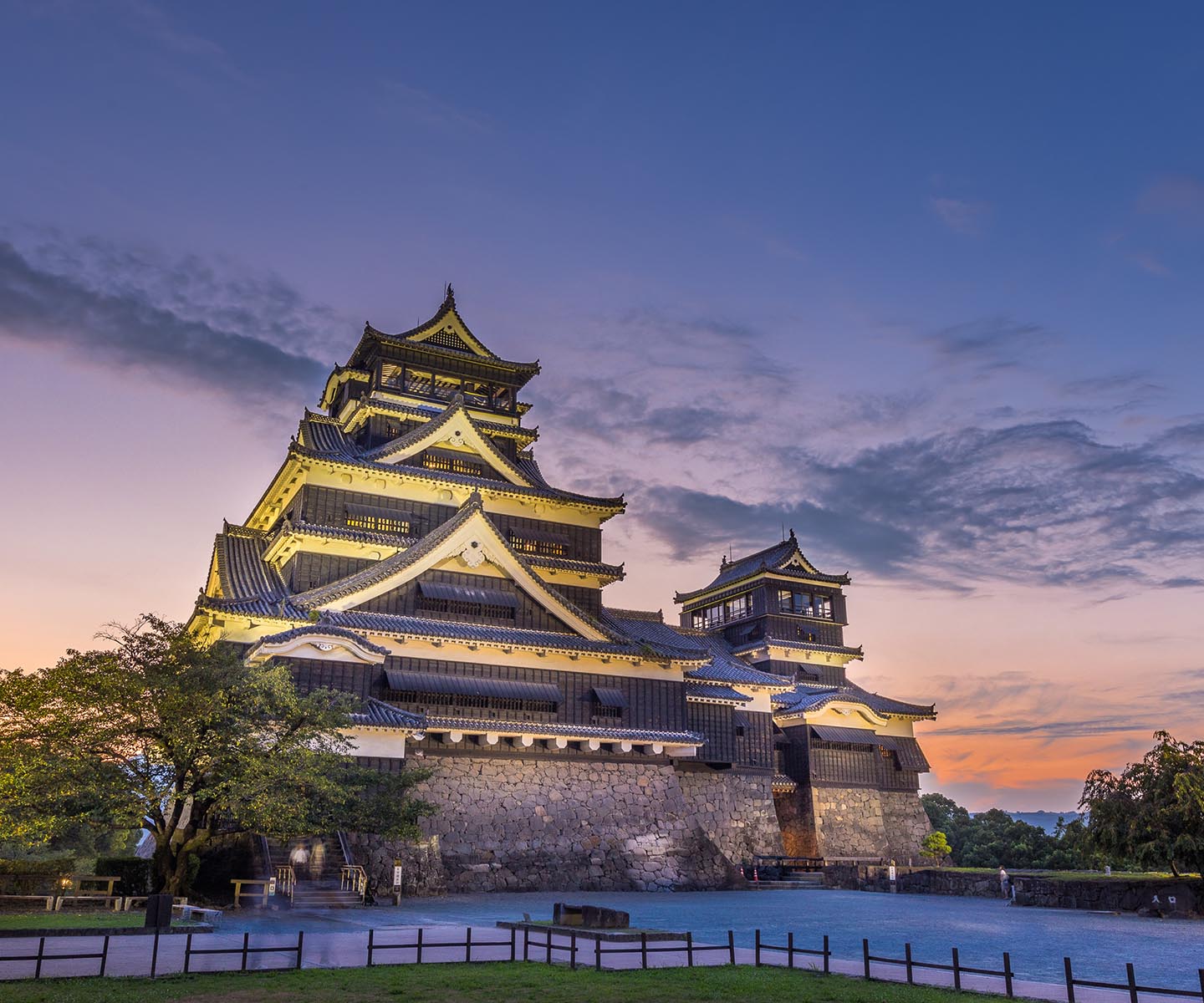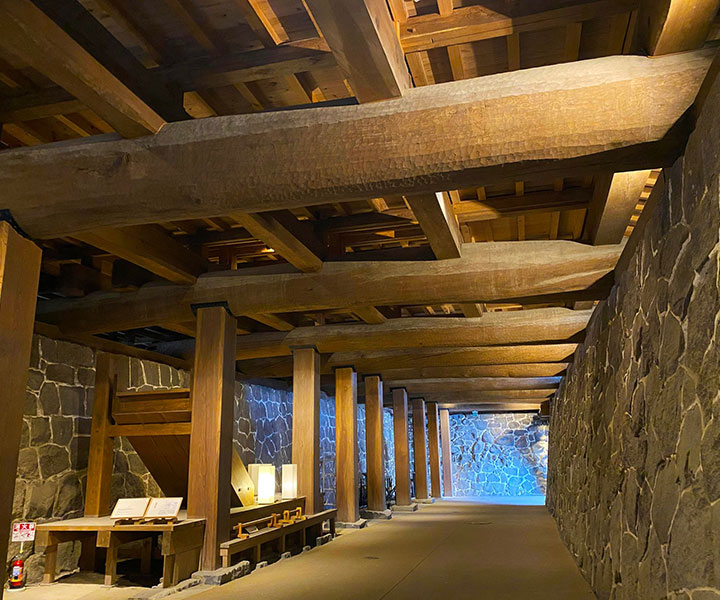- TOP
- 能楽を旅する 熊本城_en
The History of the Kumamoto Castle and Its Key People

The castle was built by Kato Kiyomasa, a famous castle builder
A different castle was initially built in the same place where Kumamoto Castle is located.
In 1587, Sassa Narimasa became the lord of the castle and attempted to rule Higo Province (present-day Kumamoto Prefecture) but failed and was ousted.
After that, Kato Kiyomasa became the lord of the castle.Kato Kiyomasa became the feudal lord of Higo Province for his achievements in the Battle of Sekigahara, completing the Kumamoto Castle in 1607.

The eleventh head of the Hosokawa Family of Kumamoto served as the lord of the castle
After Kato Kiyomasa's death, his successor, Kato Tadahiro, took power. However, in 1632, Tadahiro Kato was exiled on suspicion of treason.Hosokawa Tadatoshi (Photo left), the lord of Kokura Castle in Buzen, became the lord of the castle.
The Hosokawa family was a family of feudal lords who served Oda Nobunaga, Toyotomi Hideyoshi, Tokugawa Ieyasu, and others. Eleven generations of the Hosokawa family held the castle for 240 years after Hosokawa Tadatoshi entered the castle.
However, Kumamoto Castle was destroyed by fire just before the Seinan War, and many of its buildings, including the castle keep, were lost.
Discover the relationship between Kumamoto Castle and Noh!
Kumamoto Castle × Noh

Kato Kiyomasa, Who Re-established Two Sacred Noh
Kato Kiyomasa is known to have been very fond of Noh. He spent time at Kumamoto Castle with Nakamura Masanaga of the Konparu school. Kato Kiyomasa organized a grand Noh performance on the main Noh stage of Kumamoto Castle, and there are records of him dancing the Noh "Ebira" himself.
Furthermore, Kato Kiyomasa re-established the "Goshinji Noh" (Noh plays dedicated at shrine festivals) at Fujisaki Hachimangu Shrine (photo) and Kitaoka Shrine.
Today, the Fujisaki Hachimangu Shrine Goshinji Noh is one of the events of the Fujisaki Hachimangu Shrine Autumn Festival held every September, and dances have been dedicated by Noh performers of the Konparu and Kita schools at the Danzan Otabisho Noh stage for over 400 years.

“Kikuchi No Matsubayashi Onoh” Was Also Restored
The Hosokawa family was a family that respected the study and culture. They were known as a feudal lord who loved Noh.
Hosokawa Tadatoshi , the first generation, and Hosokawa Mitsunao, the second generation, took in Noh performers of the Konparu and Kita schools and popularized Noh widely.
From 1661 to 1673, when Hosokawa Tsunatoshi was the third lord of the domain, the old-fashioned dance Kikuchi no Matsubayashi Onoh (photo) was also revived, and from then on Noh enjoyed a long period of prosperity in Kumamoto.

Five Noh Stages Exist in Kumamoto Prefecture Today
In addition to the Otabisho Noh stage and the Kikuchi Matsuhayashi Noh stage, there are three other existing Noh stages in Kumamoto Prefecture: the Izumi Shrine Noh stage, the Kawashiri Shrine Noh stage, and the Kitaoka Shrine Maiden (all in Kumamoto City).
Of these, the Izumi Shrine Noh Theater (photo) is located in Suizenji Park under Kumamoto Castle and was relocated in 1986 from a Noh stage that belonged to the Matsui family, a vassal of the Hosokawa family.
An impregnable castle built by Kiyomasa Kato
Highlights of Kumamoto Castle

Mushagaeshi Stonewalls, a.k.a. “The Return of the Warrior”
Kumamoto Castle, one of the three most famous castles in Japan, is known for its beautifully curved stonewalls called "Mushagaeshi stonewalls" or "the return of the warrior" (photo). It is known as "Mushagaeshi," because no enemy can climb it.
The solid stonewalls that stretch across the entire castle area protected it from enemy forces during the Seinan War in 1877, proving that it was an impregnable and solid castle. However, the 2016 Kumamoto earthquake caused some of the stone walls to sink.

Main and Minor Castle Towers
In 1960, the long-lost main and minor castle towers were reconstructed on the site of the Honmaru. They were faithfully restored to a high degree of reproduction, even down to the number of tiles.
The main castle tower is very large, and inside is a branch of the "Municipal Museum of Kumamoto" where materials on the construction of the castle are exhibited.
From the top floor, you can see as far as the distant mountains of Aso. It was damaged in the Kumamoto earthquake, but is currently undergoing restoration.

Honmaru Palace (Main Building)
Udo Yagura (Udo tower), which was not damaged by fire just before the Seinan War, is one of the highlights of Kumamoto Castle. Udo Yagura remains today as it was when the castle was built. It is also called the "third castle tower" because its size and structure are comparable to those of the castle tower.
Another must-see is the Honmaru Goten, rebuilt in 2008 to commemorate the 400th anniversary of the castle's construction.The luxurious hall "Shokun-no-Ma" (photo) and other rooms have been faithfully restored, and the building has a rare underground passageway made of stone walls under the floor, called The Kuragari-Tsuro (The Dark Passage).
Photo Gallery

Main and minor castle towers (right)

Various turrets in the foreground, the Honmaru Palace above it, and the main keep towering behind it.
Access
- Address
1-1 honmaru,
Chuo-ku,Kumamoto-shi,Kumamoto-ken 860-0002
Japan- Phone
- Traffic Guide
About 10 minutes by car from JR Kumamoto station
- Bus Stop
10 minutes walk from "Kumamoto-Jhou・Shiyakusyomae"
- Parking Lot
Visitors coming in standard-size cars may use the following parking lots: Ninomaru Parking Lot, Sannomaru Number One Parking Lot, Sannomaru Number Two Parking Lot, Miyauchi Parking Lot, and Sakurano-Baba Tourist Information Office Parking Lot.
- Official WebSite
Photos provided by: Kumamoto Castle General Office, Kumamoto Prefectural Tourism Federation, and Kikuchi City Board of Education (photos of Matsuhayashi Onoh in Kikuchi)









